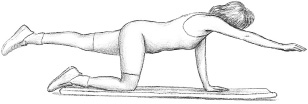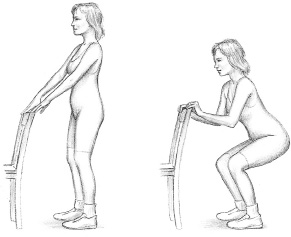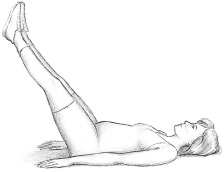Your After-Pregnancy Workout
After your baby is born, continue the
exercises you did during pregnancy. Add some of the following exercises
to help you focus on specific areas, especially abdominal muscles. Do
these exercises when your healthcare provider gives you permission.
Start slowly and gradually work harder. If you had a Cesarean delivery,
ask your healthcare provider which exercises to avoid until you get his
or her OK.
Back Bridge
Strengthens back, legs and buttocks
Lie
flat on your back on the floor, with knees bent and feet flat. Inhale,
then slowly lift buttocks and back in a straight line. Hold for 4
seconds. Exhale and lower your back to the floor so your upper back
touches the floor, then your waist touches, then your pelvis touches
last. Do 4 or 5 times.
The Crunch
Strengthens abdominal muscles
Lie
flat on your back on the floor, with knees bent and feet flat. Put your
hands on your abdomen. Suck in your abdomen, pulling your navel toward
your spine. Hold 4 seconds and release. When you are able to do 8
repetitions, lift your head toward your chest. Hold for 4 seconds, then
lower head and hold for 4 seconds. Work up to 10 repetitions.
Leg and Pelvic-Floor Strengthener
Strengthens legs and pelvic floor
Lie
on your back with your arms out at your sides. Cross your right ankle
over your left ankle; squeeze legs together. Hold 5 seconds and
release. Repeat for other ankle. Do 5 times on each side.

Back Stretch
Strengthens buttocks, back muscles and leg muscles
Kneel
on hands and knees, with wrists directly beneath shoulders and knees
directly beneath hips. Keep your back straight. Contract abdominals,
then extend your left leg behind you at hip height. At same time,
extend your right arm at shoulder height. Hold 5 seconds and return to
kneeling position. Repeat on other side. Start with 5 exercises on each
side, and gradually work up to 8.

Chair Squat
Strengthens hips, thighs and buttock muscles
Lightly
grasp the back of a chair or a counter for balance. Stand with feet
shoulder-width apart. Keep body weight over heels and torso erect. Bend
knees and lower torso in squatting position. Don’t round your back.
Hold squatting position for 5 seconds, then straighten to starting
position. Start with 5 repetitions and work up to 10.

Leg Raises
Good for abdominal muscles
Lie
flat on your back with legs straight. Slowly lift both legs from the
hip at the same time, using abdominal muscles. Hold for 5 seconds.
Slowly lower both legs together to the floor. Start with 2 repetitions
and work up to 6.

Time-Saving, Energy-Saving Tip
One exercise you can do during
pregnancy may also help during labor. Breath training decreases the
amount of energy you need to breathe, and it improves the function of
your respiratory muscles. These are the muscles you will use during
labor and delivery. Practice these three exercises now for benefits in
the near future.
•Purse your lips.
Breathe in through your nose, and exhale through pursed lips. Making a
little whistling sound is OK. Breathe in for 4 seconds, and breathe out
for 6 seconds.
•Diaphragm breathing.
Using your diaphragm muscle to breathe is beneficial. Lie on your back
in a comfortable position. Place your hand on your abdomen while
breathing. If you breathe using your diaphragm muscles, your hand will
move up when you inhale and down when you exhale. If it doesn’t, try
using different muscles until you can do it correctly.
•Bend forward to breathe.
If you bend slightly forward, you’ll find it’s easier to breathe. If
you feel pressure as your baby gets bigger, try this technique. It may
offer some relief